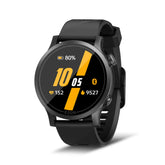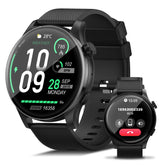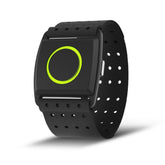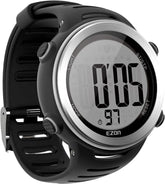Strength Training for Runners: Reduce Injury and Improve Pace
Running is a repetitive motion that places significant stress on your joints and muscles. Incorporating strength training for runners can transform your performance by boosting power, refining running form, and reducing the risk of injuries like shin splints or IT band syndrome. In this guide, we’ll explore targeted exercises, injury prevention strategies, and how a heart rate monitor can optimize your strength sessions for better running economy and pace.
Why Strength Training Is Non-Negotiable for Runners
1. Injury Prevention Through Muscle Balance
- Common Weaknesses: Runners often neglect core, glutes, and hip stabilizers, leading to overcompensation and injury.
- Science Behind It: Strong muscles absorb impact forces, reducing stress on knees and ankles. A 2020 study in the Journal of Sports Medicine found strength training cuts running injuries by 50%.
2. Pace Improvement Through Power Development
- Faster Strides: Stronger leg muscles (quads, hamstrings, calves) generate more force, improving stride length and turnover.
- Running Economy: Efficient movement requires less energy, allowing you to maintain faster paces with the same effort.
Key Muscle Groups to Strengthen
1. Core: The Foundation of Running Form
- Why It Matters: A strong core keeps your torso stable, reducing energy waste and improving posture during runs.
-
Exercises:
- Plank Variations: Standard planks (3x60 seconds), side planks, and plank shoulder taps to engage obliques.
- Dead Bugs: Lying on your back, extend opposite arm/leg to improve anti-rotation strength.
2. Glutes and Hips: The Power Generators
- Common Issue: Weak glutes lead to hip drop, causing knee valgus (inward collapse) and IT band friction.
-
Exercises:
- Glute Bridges (Single-Leg): 3x15 reps per leg to activate gluteus maximus.
- Clamshells: 3x20 reps per side to strengthen hip abductors and prevent hip tilt.
3. Lower Legs: Shock Absorption and Propulsion
- Focus on: Calves (gastrocnemius/soleus) and tibialis anterior (shin muscles).
-
Exercises:
- Calf Raises (Weighted): 4x20 reps to improve push-off power.
- Single-Leg Tibialis Raises: Sit on a chair, lift toes toward knee to strengthen shin muscles and prevent shin splints.
4. Upper Body: Arm Swing Efficiency
- Why It Matters: Controlled arm swing (90-degree angle, forward-backward motion) aids balance and momentum.
-
Exercises:
- Push-Ups and Rows: Build chest/back strength to maintain upright posture during fatigue.
- Resistance Band Pull-Aparts: 3x20 reps to open the chest and improve shoulder mobility.
Strength Training Strategies to Boost Pace
1. Power Exercises for Explosiveness
- Plyometrics: Box jumps, skater jumps, or jump squats (3x8 reps) to improve neuromuscular coordination and stride power.
- Heavy Lifts: Back squats and deadlifts (3x6–8 reps at 80% 1RM) to build maximal strength, translating to faster sprinting ability.
2. Eccentric Training for Muscle Resilience
- What It Is: Focus on the “lowering” phase of lifts to build muscle density and reduce DOMS (delayed onset muscle soreness).
- Example: Eccentric lunges—take 3 seconds to lower into the lunge, 1 second to rise, 3x10 reps per leg.
3. Core Stability During Movement
- Anti-Rotation Work: Russian twists with a weight or Pallof presses to maintain core rigidity while running.
Using a Heart Rate Monitor to Optimize Strength Sessions
1. Control Intensity for Muscle Growth vs. Endurance
- Hypertrophy (Muscle Growth): 70–85% of 1RM, 8–12 reps, 60–90 seconds rest (heart rate 70–80% MHR).
- Strength Development: 85–95% of 1RM, 1–6 reps, 2–3 minutes rest (shorter rest keeps heart rate elevated for metabolic stress).
2. Track Recovery Between Sets
- Heart Rate Recovery (HRR): A fast drop in heart rate post-set indicates good cardiovascular fitness—aim for HR to return to 60–70% MHR before the next set.
3. Avoid Overtraining
- Resting Heart Rate (RHR): Monitor RHR daily with your heart rate monitor—a 5–10 BPM increase signals fatigue, prompting a deload week.
Sample Weekly Strength Routine for Runners
| Day | Focus | Exercises (3 sets unless noted) | Reps/Rest |
|---|---|---|---|
| Monday | Glutes + Core | Glute bridges (single-leg), planks, clamshells | 15 reps/60 seconds |
| Wednesday | Lower Body Power | Back squats, box jumps, calf raises | 8–10 reps/90 seconds |
| Friday | Core + Upper Body | Push-ups, rows, dead bugs, Pallof presses | 12–15 reps/60 seconds |
Key Tips:
- Pre-Workout Warm-Up: 10 minutes of dynamic stretches (leg swings, hip circles) and light cardio (jumping jacks) to raise heart rate to 60% MHR.
- Post-Workout Recovery: Foam roll major muscle groups and do static stretches (hamstrings, hip flexors) to improve mobility.
Injury Prevention: Common Weaknesses to Address
1. IT Band Syndrome
- Cause: Tight hips and weak glutes lead to IT band friction.
- Solution: Strengthen hip abductors (clamshells, side planks) and foam roll the IT band daily.
2. Shin Splints
- Cause: Overload on tibialis anterior from weak shin muscles or sudden mileage increases.
- Solution: Tibialis raises, eccentric calf drops, and gradual mileage increases (10% rule).
3. Patellar Tendinitis
- Cause: Knee misalignment from weak vastus medialis (inner quad).
- Solution: Single-leg squats, leg curls, and avoiding deep knee flexion in weak states.
Gear to Enhance Your Strength Training
1. Heart Rate Monitor for Intensity Control
- EZON Heart Rate Series: ECG-grade sensors track heart rate during lifts, ensuring you’re in the optimal zone for muscle growth or strength.
2. Resistance Bands and Dumbbells
- Portable and Versatile: Use bands for hip activation drills and dumbbells for unilateral exercises (single-leg deadlifts).
3. Foam Roller and Massage Ball
- Recovery Essentials: Release tight fascia in the IT band, glutes, and calves post-workout.
Integrate Strength Training into Your Running Plan
1. Frequency: 2–3 sessions/week, never on consecutive days (allow 48 hours for muscle repair).
2. Timing: Schedule strength sessions on easy run days or rest days to avoid interfering with key running workouts (tempo, intervals).
3. Progression: Gradually increase weight/reps every 4–6 weeks to challenge muscles and prevent adaptation plateaus.
Stronger Muscles, Faster Runs
By prioritizing strength training for runners and using a heart rate monitor to refine intensity, you’ll build a resilient body that runs faster, stays injury-free, and moves with efficient running form. Remember, the strongest runners aren’t just those who log miles—they’re the ones who balance mileage with intentional strength work.
Start with the foundational exercises above, track your progress with heart rate data, and watch as your pace improves and injury risks fade. Your legs (and race times) will thank you.









